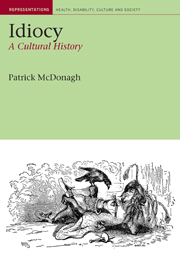Book contents
- Frontmatter
- Contents
- Preface and acknowledgements
- 1 Introduction: idiocy, culture and human relations
- 2 ‘Stripping our own hearts naked’: William Wordsworth and John Wilson read ‘The Idiot Boy’
- 3 A ‘pupil of innocent Nature!’ The wild boy of Aveyron goes to Paris
- 4 Diminished men: masculinity and idiocy
- 5 Essential women: femininity and idiocy
- 6 Holy fools, witty fools, depraved fools: folly, innocence and sin
- 7 History, society, economy: holy fools and idiots come home in nineteenth-century literature
- 8 Barnaby Rudge, idiocy and paternalism: assisting the ‘poor idiot’
- 9 Innocence, philanthropy and economics: the new ‘asylum’ idiot
- 10 Sensational idiocy
- 11 ‘The sins of the fathers’: idiocy, evolution and degeneration
- 12 Danger and degeneracy: the threat of the urban idiot
- 13 The problem of the feeble-minded: the Royal Commission, eugenics and eternal chaos
- Epilogue
- Bibliography
- Index
12 - Danger and degeneracy: the threat of the urban idiot
- Frontmatter
- Contents
- Preface and acknowledgements
- 1 Introduction: idiocy, culture and human relations
- 2 ‘Stripping our own hearts naked’: William Wordsworth and John Wilson read ‘The Idiot Boy’
- 3 A ‘pupil of innocent Nature!’ The wild boy of Aveyron goes to Paris
- 4 Diminished men: masculinity and idiocy
- 5 Essential women: femininity and idiocy
- 6 Holy fools, witty fools, depraved fools: folly, innocence and sin
- 7 History, society, economy: holy fools and idiots come home in nineteenth-century literature
- 8 Barnaby Rudge, idiocy and paternalism: assisting the ‘poor idiot’
- 9 Innocence, philanthropy and economics: the new ‘asylum’ idiot
- 10 Sensational idiocy
- 11 ‘The sins of the fathers’: idiocy, evolution and degeneration
- 12 Danger and degeneracy: the threat of the urban idiot
- 13 The problem of the feeble-minded: the Royal Commission, eugenics and eternal chaos
- Epilogue
- Bibliography
- Index
Summary
The crowd of parents, awaiting their appearance before a school board ‘B’ committee, mills outside the room on the second floor of the school building. The year is 1883, and they have been summoned to the meeting to explain before a group of school board officers why their children have been missing school, which had been made compulsory with the 1870 Education Act. When Mrs Jones, ‘a decent-looking woman’, takes her turn to explain why her daughter has been missing classes, she is accompanied by her nursing baby and ‘a small boy, with staring eyes that seem fixed upon nothing in particular – a strange, uncanny, big-headed child, who attracts attention directly’. As reported by George R. Sims, a popular journalist and playwright attending the meeting as part of his research for a series of articles under the general rubric ‘How the Poor Live’ for The Pictorial World, a London tabloid, Mrs Jones then claimed:
it's that boy as is the trouble. Ye see, sir, he can't be lef' not a minnit without somebody as can get after him quick. He's allers settin' hisself afire. He gets the matches wherever we 'ides 'em, and he lights anything he sees – the bed, the baby, hisself. Bless you, gen'lemen, it's orful; he can't be off settin' somethin' alight not five minnits together. He ain't right in 'is 'ed, sir.
- Type
- Chapter
- Information
- IdiocyA Cultural History, pp. 289 - 308Publisher: Liverpool University PressPrint publication year: 2008

